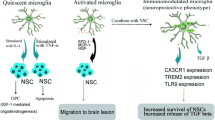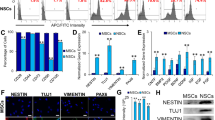Abstract
Multiple sclerosis (MS) is an immune-mediated demyelinating disease of the central nervous system (CNS). A potential new therapeutic approach for MS is cell transplantation which may promote remyelination. We transplanted human Wharton’s jelly stem cell-derived oligodendrocyte progenitor cells (hWJ-MSC-derived OPCs) into the brain ventricles of mice induced with experimental autoimmune encephalomyelitis (EAE), the animal model of MS. We studied the effect of the transplanted OPCs on the functional and pathological manifestations of the disease. Transplanted hWJ-MSC-derived OPCs significantly reduced the clinical signs of EAE. Histological examinations showed that remyelination was significantly increased after transplantation. These results suggest that hWJ-MSC-derived OPCs promote the regeneration of myelin sheaths in the brain.









Similar content being viewed by others
References
Gironi M, Bergami A, Brambilla E, Ruffini F, Furlan R et al (2000) Immunological markers in multiple sclerosis. Neurol Sci 21(4 Suppl 2):S871–S875
Hemmer B, Cepok S, Nessler S, Sommer N (2002) Pathogenesis of multiple sclerosis: an update on immunology. Curr Opin Neurol 15:227–231
Lassmann H (2002) Mechanisms of demyelination and tissue destruction in multiple sclerosis. Clin Neurol Neurosurg 104:168–171
Franklin RJ (2002) Why does remyelination fail in multiple sclerosis? Nat Rev Neurosci 3:705–714
Kornek B, Storch MK, Weissert R, Wallstroem E, Stefferl A et al (2000) Multiple sclerosis and chronic autoimmune encephalomyelitis: a comparative quantitative study of axonal injury in active, inactive, and remyelinated lesions. Am J Pathol 157:267–276
Trapp BD, Peterson J, Ransohoff RM, Rudick R, Mork S et al (1998) Axonal transection in the lesions of multiple sclerosis. N Engl J Med 338:278–285
Ferguson B, Matyszak MK, Esiri MM, Perry VH (1997) Axonal damage in acute multiple sclerosis lesions. Brain 120:393–399
Lovas G, Szilagyi N, Majtenyi K, Palkovits M, Komoly S (2000) Axonal changes in chronic demyelinated cervical spinal cord plaques. Brain 123:308–317
Pluchino S, Zanotti L, Brini E et al (2009) Regeneration and repair in multiple sclerosis: the role of cell transplantation. Neurosci Lett 456:101–106
Ho TS, Tsai CY, Tsao N, Chow NH, Lei HY (1997) Infiltrated cells in experimental allergic encephalomyelitis by additional intracerebral injection in myelin-basic-protein-sensitizedB6 mice. J Biomed Sci 4:300–307
Tsai CY, Chow NH, Ho TS, Lei HY (1997) Intracerebral injection of myelin basic protein (MBP) induces inflammation in brain and causes paraplegia in MBP-sensitized B6 mice. Clin Exp Immunol 109:127–133
Merodio M, Irache JM, Eclancher F, Mirshahi M, Villarroya H (2000) Distribution of albumin nanoparticles in animals induced with the experimental allergic encephalomyelitis. J Drug Target 8:289–303
Engelhardt B (2006) Molecular mechanisms involved in T cell migration across the blood–brain barrier. J Neural Transm 113:477–485
Rakic LM, Zlokovic BV, Segal MB, Lipovac MH, Mitrovic DM et al (1989) Effects of sensory-motor cortical lesions on blood–brain permeability in guinea pigs. Metab Brain Dis 4:9–15
Kennea NL, Waddington SN, Chan J, O’Donoghue K, Yeung D, Taylor DL et al (2009) Differentiation of human fetal mesenchymal stem cells into cells with an oligodendrocyte phenotype. Cell Cycle 8(7):1069–1079
Louro J, Pearse D (2008) Stem and progenitor cell therapies: recent progress for spinal cord injury repair. Neurol Res 30(1):5–16
Ogawa S-I, Tokumoto Y, Miyake J, Nagamune T (2011) Induction of oligodendrocyte differentiation from adult human fibroblast-derived induced pluripotent stem cells. In Vitro Cell Dev Biol Anim 47(7):464–469
Zhang L, Zhang H-T, Hong S-Q, Ma X, Jiang X-D, Xu R-X (2009) Cografted Wharton’s jelly cells-derived neurospheres and BDNF promote functional recovery after rat spinal cord transection. Neurochem Res 34(11):2030–2039
Shang A-J, Hong S-Q, Xu Q, Wang H-Y, Yang Y, Wang Z-F et al (2011) NT-3-secreting human umbilical cord mesenchymal stromal cell transplantation for the treatment of acute spinal cord injury in rats. Brain Res 1391:102–113
Margossian T, Reppel L, Makdissy N, Stoltz J-F, Bensoussan D, Huselstein C (2012) Mesenchymal stem cells derived from Wharton’s jelly: comparative phenotype analysis between tissue and in vitro expansion. Biomed Mater Eng 22(4):243–254
Kerschensteiner M, Stadelmann C, Buddeberg BS, Merkler D, Bareyre FM, Anthony DC, Linington C, Bruck W, Schwab ME (2004) Targeting EAE lesions to a predetermined axonal tract system allows for refined behavioral testing in an animal model of multiple sclerosis. Am J Pathol 164:1455–1469
Meyer R, Weissert R, Diem R, Storch MK, de Graaf KL, Kramer B, Bahr M (2001) Acute neuronal apoptosis in a rat model of multiple sclerosis. J Neurosci 21:6214–6220
Stefferl A, Brehm U, Storch M, Lambracht-Washington D, Bourquin C, Wonigeit K, Lassmann H, Linington C (1999) Myelin oligodendrocyte glycoprotein induces experimental autoimmune encephalomyelitis in the “resistant” brown Norway rat: disease susceptibility is determined by MHC and MHC-linked effects on the B cell response. J Immunol 163:40–49
Wang S, Guan Q, Diao H, Lian D, Zhong R et al (2007) Prolongation of cardiac allograft survival by inhibition of ERK1/2 signaling in a mouse model. Transplantation 83:323–332
Keirstead HS, Nistor G, Bernal G, Totoiu M, Cloutier F, Sharp K, Steward O (2005) Human embryonic stem cell-derived oligodendrocyte progenitor cell transplants remyelinate and restore locomotion after spinal cord injury. J Neurosci 25:4694–4705
Copray S, Balasubramaniyan V, Levenga J, de Bruijn J, Liem R, Boddeke E (2006) Olig2 over expression induces the in vitro differentiation of neural stem cells into mature oligodendrocytes. Stem Cells 24:1001–1010
Kennea NL, Waddington SN, Chan J et al (2009) Differentiation of human fetal mesenchymal stem cells into cells with an oligodendrocyte phenotype. Cell Cycle 8(7):1069–1079
Kang SK, Shin MJ, Jung JS, Kim YG, Kim CH (2006) Autologous adipose tissue-derived stromal cells for treatment of spinal cord injury. Stem Cells Dev 15:583–594
Luo YC, Zhang HT, Cheng HY et al (2010) Differentiation of cryopreserved human umbilical cord blood-derived stromal cells into cells with an oligodendrocyte phenotype. In Vitro Cell Dev Biol Anim 46(7):585–589
Totoiu MO, Nistor GI, Lane TE, Keirstead HS (2004) Remyelination, axonal sparing, and locomotor recovery following transplantation of glial-committed progenitor cells into the MHV model of multiple sclerosis. Exp Neurol 187(2):254–265
Chen H, Zhang Y, Yang Z, Zhang H (2013) Human umbilical cord Wharton’s jelly-derived oligodendrocyte precursor-like cells for axon and myelin sheath regeneration. Neural Regen Res 8:890–899
Zhang H-T, Fan J, Cai Y-Q, Zhao S-J, Xue S, Lin J-H et al (2010) Human Wharton’s jelly cells can be induced to differentiate into growth factor-secreting oligodendrocyte progenitor-like cells. Differentiation 79(1):15–20
Acknowledgments
We thank the Iran National Science Foundation for the financial supports (INSF) and the Cellular & Molecular Research Center of Iran University of Medical Sciences for providing us the facilities.
Author information
Authors and Affiliations
Corresponding author
Rights and permissions
About this article
Cite this article
Mikaeili Agah, E., Parivar, K. & Joghataei, M.T. Therapeutic Effect of Transplanted Human Wharton’s Jelly Stem Cell-Derived Oligodendrocyte Progenitor Cells (hWJ-MSC-derived OPCs) in an Animal Model of Multiple Sclerosis. Mol Neurobiol 49, 625–632 (2014). https://doi.org/10.1007/s12035-013-8543-2
Received:
Accepted:
Published:
Issue Date:
DOI: https://doi.org/10.1007/s12035-013-8543-2




